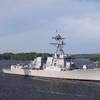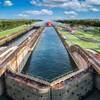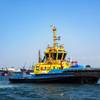"Vessels Negligent Until Proven Otherwise"
The Grosse Ill Toll Bridge (the bridge) is a privately owned toll bridge over the Detroit River. The bridge opens for vessel traffic with a pivot system. It has a 305 ft. swing span in the center of the bridge that pivots open allowing for the passage of vessels. Bracketing the swing section are two 180 ft. fixed spans that allow for a 125 ft. draw once the swing span is open. Therefore, the bridge allows for little margin of error for a ship such as the M/V White which is 78 ft. wide to pass through the 125 ft. draw.
The day before September 6, 1992, the M/V White radioed notice to the bridge operators that the ship was coming. The bridgetenders expected the ship to arrive shortly after two o'clock p.m. that day. About a mile before the M/V White approached the bridge, it picked up two tugboats to help control the ship's lateral movement as it passed through the bridge's draw. The captain of one of the tugboats informed the bridgetender over the radio that the M/V White and its tugboats would be at the bridge in the next 10 to 15 minutes. The bridgtenders acknowledged the call and responded that they would be looking out for the vessel.
The tugboat captain again radioed the bridgetender to say that they would arrive at the bridge in about 5 minutes. The bridgetender again acknowledged the call and responded that they were ready for them. The tugboat captain gave a whistle signal for the bridge to open in just a couple of minutes after the M/V White reached Red Buoy 28. This buoy is the point in the channel where it is customary to give the signal to open the bridge when towing a ship. However, the bridge did not respond. The tugboat captain blew a second open-bridge signal and radioed the bridgtender three times, but received no reply.
The M/V White then approached Green Buoy 25 and Red Buoy 26, which are located approximately 2,000 ft. above the bridge. These buoys are considered the "point of no return" for a ship the size of the M/V White. It was the custom and practice of the bridge to begin opening the pivotal span for an approaching ship no later than Red Buoy 28, which is 3,000 ft. north of Buoys 25 and 26.
Upon reaching the "point of no return" buoys, both the tugboat captain and the captain of the M/V White blew their danger signals. The ship's lookout testified that he saw a vehicle on the bridge quickly back away from the center section, but then later saw two more vehicles drive onto this center section. At this point, the captain of the M/V White decided that he had to stop the vessel in order to avoid a collision. The captain radioed to the tugboats that he was going to back down the engine which would cause the bow of the vessel to swing to the port side. The M/V White's engine was put into reverse, causing the bow to veer to port and thus lose alignment with the planned draw through the open bridge.
Sometime after these measures were taken, the bridge began to open. When the M/V White was just 200 to 300 ft. from the bridge, it dropped its 13,000 lb. port-bow anchor. Although the M/V White had come to an almost complete stop when it reached the bridge, the bow tapped the stationary span. Due to the size and momentum of the M/V White, the slight tap was enough to knock down the entire 180 ft. span. The bridge was actually fully open by the time the ship hit the stationary span.
This incident led to a seven week trial before a federal district court in Michigan. The trial judge ultimately concluded that the Grosse Ile's actions and inactions in this matter caused the collision, and the M/V White bore no responsibility for the accident. Gross Ile filed an appeal, and the United State Court of Appeal for the Sixth Circuit agreed with the trial court on all but one of the issues.
According to the Sixth Circuit, the trial court erred in concluding that the M/V White was free from blame for this accident. The Sixth Circuit agreed with the trial court that there was sufficient evidence that one of the bridgetenders had been drinking that day. The appellate court also agreed with the trial court that the M/V White posted a proper lookout on the ship, and that the M/V White was reasonable in proceeding toward the bridge after it received an invitation to proceed from the bridgetenders. However, the Sixth Circuit did not agree with the trial court that the M/V White acted reasonably in dropping its anchors when it did. According to the Sixth Circuit, the decision by the M/V White's captain not to drop the port-bow anchor earlier than it did was unreasonable and completely inconsistent with the captain's strategic decision to stop the ship short of the bridge.
The tenor of the Sixth Circuit's opinion is that once the captain decided to reverse the ship's engine, he knew or should have known that his ship would lose alignment and make safe passage impossible. At that point, the port-bow anchor should have been dropped. However, the captain of the M/V White did not try to stop the ship by dropping the port-bow anchor earlier than he did because of the unrealistic hope that the ship could nevertheless proceed through the draw. The Sixth Circuit acknowledged that this was an emergency situation that the captain of the M/V White was faced with through no fault of his own. Therefore, his actions were scrutinized less harshly than in cases where there is no apparent emergency. Nevertheless, even in this emergency situation the captain of the vessel must make a reasonable strategic decision and then stick with it. Accordingly, the case was sent back to the trial court for further proceedings to determine what amount of fault should be attributed to the M/V White. That decision is still pending.
Under maritime law, there are certain presumptions that apply whenever there is a collision between two vessels or a vessel and a stationary object. For example, the so-called Pennsylvania Rule holds that where a vessel at the time of a collision is in violation of a statutory or regulatory rule intended to prevent such a collision, the violation is presumed to be at least a contributory cause of the accident. The offending vessel must counter this presumption by showing that its conduct did not contribute to the collision. In the case of the M/V White, the Pennsylvania Rule played a large part in determining who was at fault for this accident. It was alleged that the M/V White was in violation of several statutory or regulatory rules such as failure to keep a proper lookout and proceeding toward the bridge before receiving an invitation to proceed. The M/V White successfully rebutted these presumptions.
There was another general presumption that the M/V White was faced with in this case. That presumption holds that when there is a collision between a moving vessel and a stationary object, the vessel is presumed to be at fault. The term presumption is a term of art and its legal significance should not be overlooked. A presumption in law is not the same concept as something that is deemed to be true. When something is deemed to be true under the law, it cannot be rebutted with contrary evidence. The only way to overcome this is if there is an excuse for the action but such an excuse is usually narrowly defined and only provided by statute. On the other hand, a presumption may be overcome by evidence that rebuts the presumption. The legal significance of the presumption is that it shifts the burden of proof to the person or entity against whom the presumption applies. In other words, the M/V White had to show that its actions did not cause this accident-a burden that the M/V White did not meet according to the Sixth Circuit.
What does this mean to vessel owners and operators? It means that the final decision on whether the vessel has rebutted the collision presumptions mentioned above rests with the judge. It also means that for vessels involved in collisions with stationary objects, there is no such thing as presumed innocent until proven guilty. Rather, it is presumed negligent until proven otherwise.
Authors: James Nader is a partner and C. Devin Fadaol is an associate with the law firm of Lobman, Carnahan, Batt, Angelle & Nader in New Orleans, La. Mr. Nader¹s trial practice over the last eighteen years has included Admiralty and Maritime Law, an area in which he is an adjunct professor at Tulane University. Mr. Fadaol's primary practice areas include insurance defense and general civil litigation. For more information on the firm, please see it's Website at www.lcba-law.com, or contact them at 400 Poydras St., Suite 2300, New Orleans, LA 70130, phone (504) 586-9292.
**This article is for general information and educational purposes only, and should not be construed as legal advice. The authors are available to discuss any specific questions or concerns regarding any issues related to this article with you.














